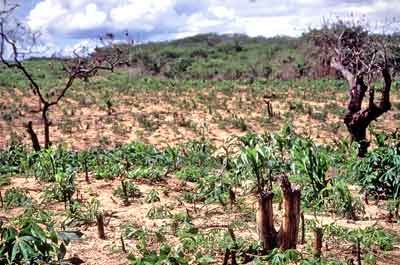


N. Byron
In renewing forest policy the bottom line is to ask, “What would be in the best long-term interest for the whole society, not just for a specific industry or sectoral group?”
Neil Byron is one of five independent commissioners who advise the Australian Government on reform of economic, social and environmental policies.
This article was adapted from a keynote speech presented at the Expert Consultation on Establishing a Regional Forest Policy Network for Asia and the Pacific, held by the FAO Asia-Pacific Forestry Commission in Manila, the Philippines, 2–3 March 2006.
Forest policy-making does not start from a blank sheet of paper. Almost every country has a formal written forest policy statement, even those that do not have de facto policies. Many important matters derive from such a policy: legislation and regulations, government structures, research facilities and educational centres, industry organizations and professional bodies. At the most basic level, the issue is, “Who will manage forests, for what purpose?” “Who” might be government agencies, private companies, community groups, indigenous people or private individuals, or in most cases some mix of all these. In many countries, “for what” has conventionally been predominantly or solely industrial timber production. However, ecosystem services (including biodiversity conservation, watershed management and recreation), which have been locally important in some countries for centuries, are increasingly becoming of greater and wider importance, especially in the more affluent countries. Rural development and poverty alleviation are increasingly recognized as important in the less affluent countries, with widespread realization that the so-called “minor forest produce” can be of huge significance to hundreds of millions of people (Byron and Arnold, 1999).
Whatever the official forest policy is today, one can ask:
Is it effectively a timber supply policy – an arrangement between the government forest service and the wood industries? Or is it a policy about how forests will be managed, by and for whom, to provide the best possible mix of social, environmental and economic benefits in that jurisdiction? Does it recognize that even well-informed and well-intentioned people will have different priorities and preferences at any given time and place, and that those priorities change with time and place?
| In responding to the best interests of their constituency, policy-makers need to address the question of whose interests count |
 |
| FAO/FO-0100 |
Policy decisions are made by governments responding to what they believe is in the best interests of their constituency. The constituency has at least two elements:
One hallmark of effective policies is the commitment of the whole government. For example, an examination of Australia’s water policy revealed that there are many vitally interested stakeholders apart from irrigators and engineers, and the country’s policies and procedures for historical heritage conservation have run into conflict with building safety, energy efficiency and access for disabled people, as well as property owners’ rights. The railway policy, which ignored the interests and actions of road, air and shipping transport, was useless, ineffectual and often counterproductive. Some countries’ official forest policies seem to be like that. If a national forest policy is going to be effective, it should not just come from the department or ministry responsible for forests, but must have the commitment of the whole government and society-wide support.
The world is continuously changing economically, socially, demographically and even climatically. But policy, by definition, is fixed for years, perhaps decades, until something triggers a serious re-evaluation. Potential triggers can be categorized in three groups: implementation failures, changes in social priorities, and new opportunities.
Implementation failures eventually become impossible to ignore; reality catches up to rhetoric. One personal observation of this was when the Planning Commission of Bangladesh discovered through satellite imagery that 90 percent of the plains forests in Bangladesh had no trees. Perhaps naively, the national policy and funding programmes had assumed that there were trees to be managed and protected, and that “National Forest” did not simply mean areas of bare land or farmlands, theoretically administered by the Forestry Department. Many forest policy statements could win prizes for science fiction because they are so filled with fantasy: guesses about growth rates; assumptions of zero encroachment; assumptions that the only logs ever removed were those where a permit had been issued and the appropriate fee paid; assertions that a country had 10x ha of forest plantations after ten years of replanting the same x ha that failed every year – when in fact there were still no plantations.
Two other personal observations have provoked assessment of the relevance and efficacy of conventional forest policy frameworks and institutions:
These anecdotes call into question whether it was appropriate or possible to transplant to newly independent countries the western model of managing large areas of valuable government-owned forest by a staff of highly educated and trained public servants. Was this model, which has worked well in the United Kingdom, North America, Australia and Western Europe, for example, really applicable in Indonesia, southern Africa, India, Bangladesh or Solomon Islands? Are the institutional arrangements set up in the colonial era consistent with the reality on the ground in those countries? Like oil, gold and diamonds, forest wealth can create a desperate scramble for cash, so the people guarding the “treasury” need to be well funded, well paid and well supervised. How can a forestry agency exert effective management control over valuable but remote forests when it is small and underfunded and has a poorly trained and underpaid staff? If the public and political support (and sufficient financial and staff resources) to implement a policy properly are lacking, then perhaps a different, more realistic forest policy is needed. Wouldn’t it be better to have a simple but adequate policy that is robust and workable, than to have an elegant, complex and sophisticated policy and institutions that are impossible to implement in the field?
Priorities change when the values of a majority of the people have changed or when people with certain values have found a stronger and more effective voice. Two areas where people’s priorities have particularly influenced forest policy change are environmental and poverty issues.
Examples of environmental concerns that have triggered major policy change include:
Repudiation of the extreme poverty of people living in or near forests is the other common social trigger. Up to 500 million people may be considered forest dependent, but many of them would probably rather not be (Byron and Arnold, 1999). Dependence on non-wood forest products (NWFPs) in developing countries has often been described by anthropologists as a livelihood of last resort. A person who has no agricultural land, no buffalo or livestock, no skills or education and no other way of earning a subsistence wage goes into the forest and ekes out the little he or she can get. So policy-makers need either to look for ways of making forest-based livelihoods (based on sustainable use) more rewarding, or to help people who are in that situation find exit strategies to move to other sectors or other locations. This is what Wunder (2005) calls “conservation by distraction”: giving the people somewhere else to go, away from the forest, should leave the forest suffering less impact.
New opportunities for policy reform sometimes emerge, particularly when large amounts of new or additional external support are offered, as in payment for ecosystem services (e.g. biodiversity conservation, catchment management, carbon sequestration) or donor assistance programmes for fuelwood, poverty alleviation or relief from HIV/AIDS (discussed further below).
In reflecting on examples like those cited above, it can be important to distinguish the publicized or immediate reasons given for policy change from underlying reasons that often are not discussed. A sudden event may provide the spark – sometimes even a false or irrelevant one – where there is plenty of dry fuel just waiting to be ignited. Sometimes various organizations want the forest policy (or forestry institutions) to change for quite different reasons. The demise of the New Zealand Forest Service, for example, was the outcome of an unlikely coalition of interests between fiscal conservatives in the Treasury concerned about imbalances in the national budget and, at the opposite political extreme, environmental non-governmental organizations (NGOs) concerned about logging in natural forests. Similarly, although there may have been no evidence proving that logging caused landslides in Thailand or the Philippines, it provided a convenient reason or pretext for politicians to take strong actions that were already being considered for other reasons.
| An example of a public environmental concern that triggered major policy change: protecting the habitat of the endangered spotted owl in the northwestern United States |
 |
| LOS ALAMOS NATIONAL LABORATORY, USA/D. KELLER |
| Immediate trigger or underlying cause? Although there may be no proof that they are caused by logging, landslides could provide a pretext for strong actions that were already being considered for other reasons |
 |
| FAO/FO-0253/T. HOFER |
| The extreme poverty of people living in or near forests is a common social trigger for policy change, aimed at providing more rewarding or alternative livelihoods |
 |
| FAO/FO-0182/M.L. WILKIE |
Since this article is concerned with the formulation and reform of public policies, it is necessary to understand how these are delivered through public organizations (such as a Forest Service which exists to implement forest policies and programmes). Every organization has a structure, functions and principles. A public organization receives inputs (resources) and is expected to deliver outputs and outcomes that are useful and worthwhile to society. Sometimes society may decide (via the government that represents its interests) that change is needed because, for example:
So the government may opt to change:
Alternatively, a government may choose to change forest policy to affect the private sector or semi-public institutions such as universities, but in this discussion the focus is on direct reform of government agencies.
If the values and principles are not changed, changing the structure and designated functions may have little effect. Fisher (1991) has written about “institutional incompatibility”, where an organization is simply inappropriate for the tasks it is expected to undertake. On the other hand, when the new Indian state of Chhattisgarh was created in 2000, its Forest Department was deliberately set up to have a completely original set of objectives and desired outcomes, accompanied by novel approaches to the who, what, how, why and with whom. Incentive structures were carefully crafted to change the values and behaviours of officials in such a way as to reinforce the new government’s social and environmental goals. As the behaviour of the officials changed, the attitudes and behaviour of the beneficiaries of the department’s activities also changed, as relationships of mutual trust developed.
Beyond the national perspective, what is the role of external or international agencies, concerns and interests in defining, implementing and redefining forest policies?
In the past 40 years or so, international forestry and related development assistance have gone through a number of different phases. The focus has moved from forestry for industrialization, job creation and foreign exchange earning through exports in the 1960s; to forestry for local community development, putting people first, fuelwood for the rural poor and forestry for basic human needs in the 1970s (Westoby, 1987); to watershed management and environmental forestry in the 1980s and 1990s. The interest in fires waxed or waned depending on El Niño. In other phases, international forestry specialists and advisers concentrated on institution building: capacity development, human resources, improved planning, forestry education and research. All of these are important, and attention to them has been variously mixed at various times in most developing countries.
Peters, Gentry and Mendelssohn (1989) broke new ground by arguing that it would be more profitable to retain the Amazon rain forest than to log it, if all the NWFPs and all the ecosystem services were valued; and that the non-industrial, conservation-compatible uses of the forest provided great benefit directly to the local people. The implication was that if ways could be devised to capitalize on all the unpriced global environmental services such as biodiversity and carbon sequestration, both social and environmental objectives could be achieved simultaneously. This idea led to a multi-billion dollar investment over the past 15 years in integrated conservation and development projects. The general consensus now is that few of these projects have lived up to expectations. Most achieved some local socio-economic benefits, but few achieved much extra conservation of forests. Basically, the underlying concept was flawed, but had profound impact anyway, because it was grasped by so many people who wished it were true.
The point is not that fashions come and go in forestry development assistance, but that donors (and often recipient countries too) seem unable to focus on more than one dimension at a time, when in fact the problems are complex and multidimensional. The focus reflects the dominant concerns and perceptions of the donors. For example, when some industrialized countries suffered an energy crisis (oil shortage) in 1973–1974, developing countries received energy programmes (fuelwood plantations and more efficient wood stoves) from 1975. When developed countries focused on biodiversity conservation, aid programmes did the same. After spectacular failures of corporate governance in some developed countries (e.g. the Enron scandal in the United States), developing countries are now being asked to improve their governance and transparency, including in forestry.
Changes usually take time to have an effect, and the sequencing of reform matters. It is often asserted that scientific advances and policy reforms take longer in forestry than in most other sectors because trees grow slowly. Yet workers in international forestry frequently conclude after only a couple of years that an initiative did or did not work and move on accordingly. On the other hand, while trees grow slowly, deforestation can be very rapid. The failure of a policy to address an urgent issue may be apparent within a few years, while a successful forest policy reform might take decades to prove its worth.
Since the 1992 United Nations Conference on Environment and Development (UNCED), forest policy-makers have engaged in seemingly endless consultations, discussions and debates about forest principles, criteria and indicators of sustainable forest management and the pros and cons of a legally binding global forest convention. But how much has changed out in the forests as a result? For most countries, the deliberations of the Intergovernmental Panel on Forests (IPF), the Intergovernmental Forum on Forests (IFF) and the United Nations Forum on Forests (UNFF) in Geneva and New York do not appear to have changed very much, and it is not clear how a new international treaty on forests or forestry would lead to more effective, efficient and equitable forest management in any specific country if national legislation has consistently failed. Some countries may be “jurisdiction shopping”: those that fear that rulings of the Convention on Biological Diversity (CBD) or the World Trade Organization (WTO) might have disagreeable impacts on forests and forestry may want to establish a different multilateral body that is more likely to give the desired rulings, even if the rulings of the different international treaties dealing with various aspects of forests turn out to be incompatible or inconsistent. Assistance to national forest programmes for specific or shared problems is more likely to help than new international forest law.
| International influence on forest policies has tended to reflect the dominant concerns and perceptions of the donors: the focus moved from industrialization in the 1960s, to local community development in the 1970s, to watershed management and environmental forestry in the 1980s |
 |
| FAO/FO-0866/S. Braatz FAO/CFU000238/R. Faidutti FAO/FO-0246/T. Hofer |
| While trees grow slowly, deforestation can be rapid – the failure of a policy to address an urgent issue may be apparent within a few years, while a successful forest policy reform might take decades to prove its worth |
 |
| FAO/14984/A. CONTI |
Challenges in forest policy reform are not new. A meeting in Bangkok, Thailand in 1992 reviewed forest policies, policies in other sectors (agriculture, environment, fisheries, tourism, industries, flood control, rural development, etc.) and possible forest policy reforms for 14 Asian countries (FAO, 1993). Some national policies that appeared very strong then have been discarded as failures. Problems identified by some countries more than a dozen years ago are now being repeated by others.
FAO’s Asia-Pacific Forestry Commission has proposed a regional think-tank or network to help countries share experiences and analyse what has been tried and what has or has not worked well and why. This would provide opportunities to avoid mistakes and to benefit from others’ lessons. It would not address only the problems that all can see – the continuing or worsening forest depletion and degradation; or the expensive projects that do not yield useful results. Sectoral outlook studies undertaken by FAO at the regional level, and by some countries at the national level, can also make a major contribution, if their scope is wide and their ambitions high. Perhaps the biggest failure is the failure to achieve the potential contribution that forestry could have made to society, the environment, rural development and economies, but sometimes has not, because of opportunities not taken.
It is essential to be explicit, at the outset, about the reasons for policy reform. Why is it necessary? Who will benefit and how? What will it cost, and to whom? Will the losers (there are always some) be compensated or accommodated? Who will be responsible for implementation of the reform, and what resources or authority will they need to achieve results? Who will be held accountable for non- compliance or non-achievement? What arrangements will be made to monitor and assess performance to see if the direction and magnitude of the innovation are still on track after five years or so?
Forests and forestry cannot single-handedly eliminate poverty and injustice across any country. Better forest policies are not going to bring misgovernment, corruption or anarchy to an end overnight. The rule of law, well-defined property rights and well-functioning markets are prerequisites to successful sustainable forest management, not attributes achieved as a result of it. Forestry programmes based on sound biophysical and socio-economic research can ensure that very poor rural people in and around forests do not become even poorer, but have opportunities to improve their standard of living while maintaining the forest such that it continues to enhance their quality of life and provide local and global ecosystem services.
An economy- and society-wide approach is key. When forest policies are analysed, formulated or implemented, they should always be integrated with the related sectors, and be realistic and practical. Offering policy outcomes that cannot be delivered will inevitably undermine the credibility and legitimacy of forest management.
 Bibliography
Bibliography
Byron, R.N. & Arnold, J.E.M. 1999. What futures for the people of the tropical forests? World Development, 27(5): 789–805.
Byron, R.N. & Shepherd, G. 1998. Indonesia and the 1997–98 El Niño: fire problems and long-term solutions. Natural Resource Perspectives No. 28. London, UK, Overseas Development Institute (ODI).
FAO. 1993. Forestry policies in selected countries in Asia and the Pacific. FAO Forestry Paper No. 115. Rome.
FAO. 2005. Forests and floods: drowning in fiction or thriving on facts. RAP Publication 2005/03, Forest Perspectives No. 2. Bangkok, Thailand, FAO Regional Office for Asia and the Pacific.
Fisher, R.J. 1991. Studying indigenous forest management systems in Nepal: towards a more systematic approach. EAPI Working Paper No. 30. Honolulu, Hawaii, USA, East West Center.
Peters, C.M., Gentry A.H. & Mendelssohn, R.O. 1989. Valuation of an Amazonian rainforest. Nature, 339: 655–656.
Turvey, N. 2006. Rainforest wars. Brisbane, Australia, Interactive Press.
Westoby, J. 1987. The purpose of forests: follies of development. Oxford, UK, Blackwell.
Wunder, S. 2005. Paying for environmental services: some nuts and bolts. CIFOR Occasional Paper No 42. Bogor, Indonesia, Center for International Forestry Research.